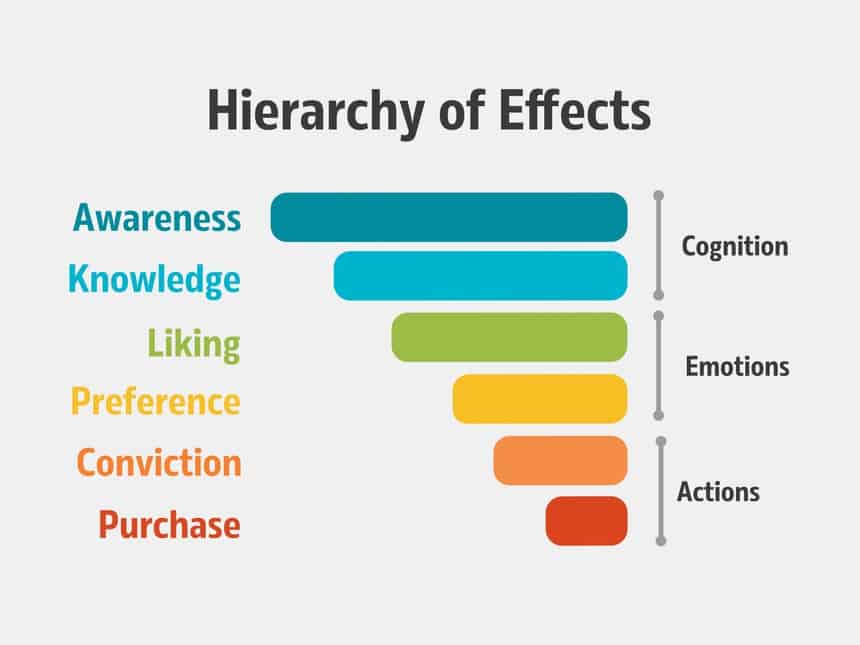The hierarchy of effects is a 50-year-old model invented by marketers Gary A. Steiner and Robert James “Bob” Lavidge. This year it celebrates 50 years of glorious existence.
The invention of Hierarchy of Effects
50 years ago in 1961, Steiner and Lavidge wrote a paper called “A Model for Predictive Measurements of Advertising Effectiveness“, in which they made the case for a different way of performing advertising research.
Their goal was to question what is the role of advertising, what functions should they perform and demonstrated what are the implications of advertising messages for marketing effectiveness.
Despite being 50 years old (half the age of the AIDA model), it is still highly popular among marketing and advertising strategists.
Compared to the 4-step model AIDA, the theoretical model of the hierarchy of effects combines 6 steps in customer decision making, with 3 different levels of decision: cognition, affection and behaviour (conative).

The 6 stages of the Hierarchy of Effects
The first and second stage cover what is called the “cognitive” area of customer psychology.
1. Awareness
It is the first stage in the purchase decision, similar to AIDA’s “Attention” step. Awareness is critical for any product, including private labels which are more price-driven.
2. Knowledge
This second layer of information is necessary for the consumer to understand what the product or service is about. Here she/he needs to get the right data about the product: what does it do, how it works.
Stages three and four cover the emotional (affective) area of a customer’s decision process.
3. Likeability
Here the useful and emotional content of marketing communication comes into play. It can be an emotional benefit (What’s in it for me?), a nice piece of storytelling, a testimonial or simply a great product image (think for example of cosmetics and fragrances advertising).
4. Preference
Here the USP or the differentiating argument makes the difference. The customer needs a strong reason to choose a brand over the others.
The last two stages in the Hierarchy of effects are related to actual behaviour, which is referred to as the “conative” level.
5. Convicingness
This is a more practical area of the human mind that needs to be addressed. The customer has made a choice but now needs to be convinced to perform an action as soon as possible. In eCommerce funnels, here is when the customer adds the product to the basket.
Here your brands’ message can include a time-limited free trial or free samples, that would encourage the customer not to postpone the buying decision.
Alternatively, you could introduce a free “product reservation” in case you offer a time-limited deal, adding a time buffer to the customer, but at the same time not putting the pressure to buy on the spot.
6. Purchase
The buying process isn’t over until the customer has purchased the product. Here you need to be prepared with the “heavy” weapons in order to maximize conversions in your store or web store.
Prepare 30 days money-back guarantee and other return policies, but also upselling and free samples of other services or products. Last but not least, if you ship your products, make sure you include some nice presents in the package.
Hierarchy of Effects vs. AIDA: Which one is better?
For start, Gary A. Steiner and Robert James “Bob” Lavidge’s model is more detailed than AIDA, which includes only 4 steps. More importantly, the newer model takes into consideration 3 psychological layers: basic understanding, emotional load and action. AIDA misses these
Biography:
